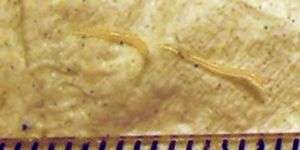Enterobius
Background

Two pinworms next to a ruler: The markings are 1 mm apart.
- Colloquially known as Pinworm (United States), Treadworm (UK and Australia) or Seatworm
- Medical infectious name: Enterobiasis
- Worldwide distribution
- Risk factors (prevalence can reach up to 50% in these populations):
- Age under 18
- Institutionalized
- Cohabitation with infected individual
- Humans only known reservoir
- Transmitted by fecal-oral route
- Can survive outside of body for up to 3 weeks
Clinical Features
- Pruritus ani (intense itching of the perianal region)
- Worse at night
- Rarer symptoms include abdominal pain, appendicitis and vulvovaginitis or dysuria in females
Differential Diagnosis
- Idiopathic pruritus ani
- Rectal tenesmus
Cestodes (Tapeworms)
- Taenia saginata
- Taenia solium (Cysticercosis)
- Diphyllobothrium latum
- Hymenolepis nana
- Echinococcus granulosus
Trematodes (Flukes)
- Fasciola hepatica
- Fasciolopsis buski
- Opistorchis viverrini
- Schistosoma spp
- Chlonorchis sinensis
- Paragonimus spp.
Nematodes (Roundworms)
- Ascaris lumbricoides
- Enterobius vermicularis (Pinworm)
- Filarial worms
- Loa Loa
- Onchocerciasis
- Lymphatic filariasis (Elephantiasis)
- Wuchereria bancrofti
- Brugia malayi
- Brugia timori
- Hookworm
- Necator americanus
- Ancylostoma duodenale
- Cutaneous larva migrans (Ancylostoma braziliense)
- Dracunculus medinensis
- Strongyloides stercoralis
- Trichuris trichiura (Whipworm)
- Anisakis
- Toxocara spp.
- Trichinosis
Evaluation
- Tape test
- Most common
- Touch transparent tape to the perianal region and examine for eggs under the microscope
- Can also test by examining scrapings under patient's fingernails or examining perianal region 2-3 hours after patient falls asleep
- Stool analysis does not work because of low egg burden in stool
Management
Management
Treatment targeted against Enterobius vermicularis
- Mebendazole 100mg PO once THEN repeat in 2 weeks OR
- Albendazole 400mg PO once (100mig if < 2yo) THEN repeat in 2 weeks OR
- Pyrantel Pamoate (Pin-x) 11mg/kg (max 1g) THEN repeat in 2 weeks
- Recommended for pregnant patients
- All family members should be treated at the same time
Prevention
- Carefully hand washing after using the toilet, and before and after eating
- Thoroughly launder all bedding, clothing, and toys to destroy any lingering eggs
- Launder all bedding every 3-7 days for three weeks
- Wash underwear and pajamas daily for two weeks
External Links
See Also
- Parasites
References
This article is issued from
Wikem.
The text is licensed under Creative
Commons - Attribution - Sharealike.
Additional terms may apply for the media files.